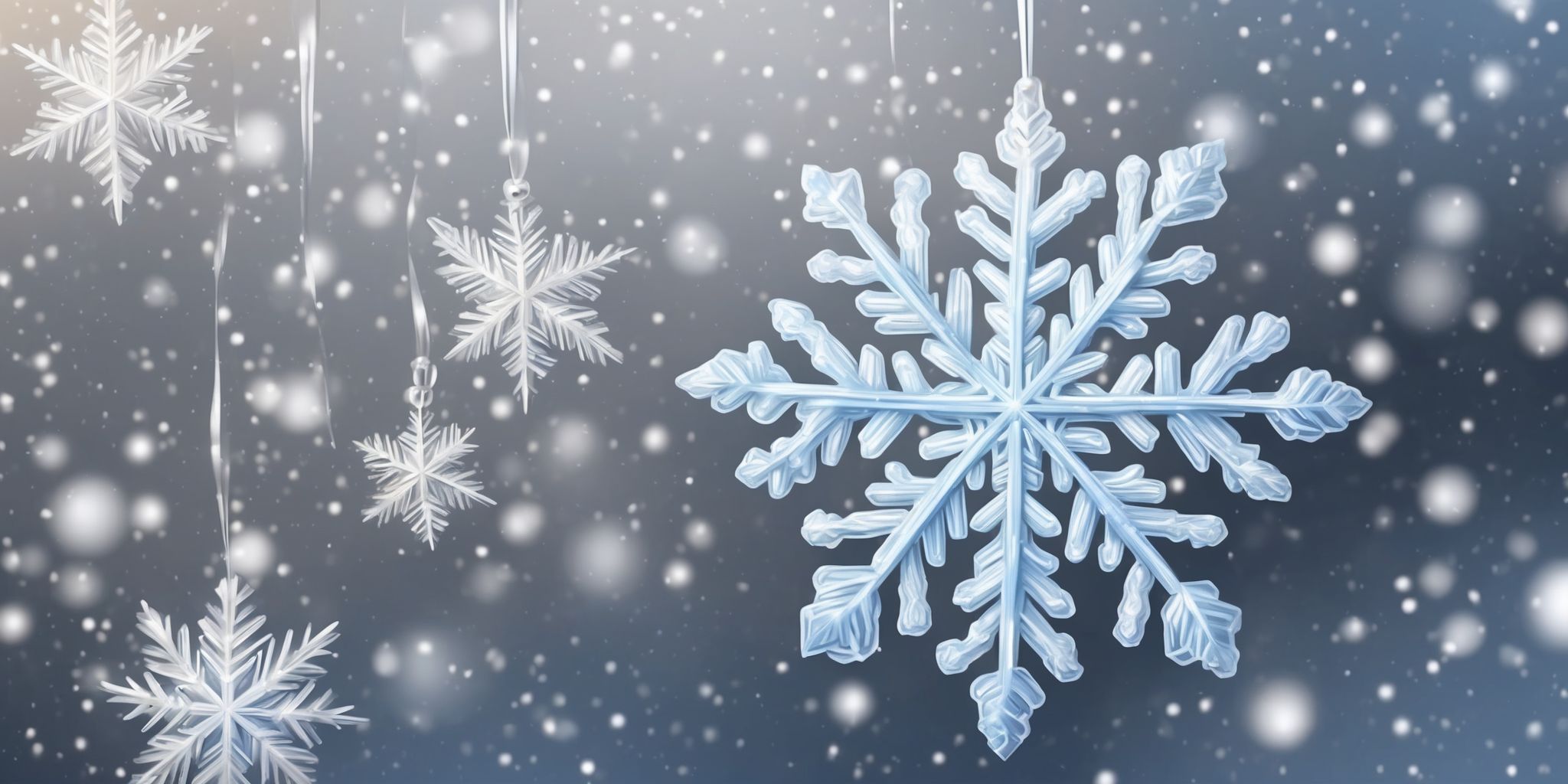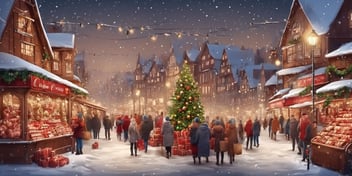- Blog
- Christmas questions
- What is the history of the Christmas market tradition?

Every year, as the calendar pages switch to December, streets magically transform into enchanting wonderlands. The air fills with the delightful aromas of roasting chestnuts, warm cinnamon, and freshly baked pastries. Sounds of laughter and joyful carols resonate through the lanes, accompanied by the jingling of bells and the occasional ho-ho-ho. Yes, you guessed it right—it's time for the much-loved Christmas markets to grace our cities once again.
But have you ever wondered how this festive tradition came to be? Let's take a journey back in time and uncover the captivating history behind the Christmas market tradition.
What are Christmas markets?
Christmas markets are festive markets that spring up during the holiday season, typically in town squares or pedestrian areas. These markets are a beloved tradition in many countries and offer a range of unique experiences. Visitors can find stalls selling a variety of goods, such as handcrafted gifts, traditional ornaments, and delicious food and drinks. Walking through the market is an opportunity to soak up the festive atmosphere, enjoy live music, and participate in seasonal activities.
From ice skating to carol singing, Christmas markets provide entertainment and a chance to immerse oneself in the joy of the holiday season.
Origin of Christmas markets
The tradition of Christmas markets dates back to the Late Middle Ages in German-speaking regions of Europe. It began as a way to celebrate the holiday season and provide a market for people to purchase necessary goods and supplies. These markets initially focused on selling items like food, decorations, and gifts. Over time, they evolved to include entertainment such as music, crafts, and games. Today, Christmas markets continue to thrive and attract visitors from all around the world.
They create a festive atmosphere, offer unique shopping experiences, and showcase local traditions and culture.
Medieval beginnings
The first Christmas market in history
The first Christmas market in history dates back to the late Middle Ages. These markets originated in German-speaking regions and were organized to celebrate the festive season. They were held in town squares and featured stalls selling food, gifts, and crafts. The market in Dresden, Germany, is one of the oldest documented Christmas markets, dating back to 1434.
These early markets set the foundation for the tradition we see today, where people gather to enjoy the holiday spirit, shop for unique items, and indulge in seasonal treats.
Evolution and spread of Christmas markets in Europe
The tradition of Christmas markets has evolved and spread throughout Europe over the centuries. These festive markets, originally held in German-speaking countries, have now become popular across the continent. The growth of transportation networks, such as railways, facilitated the expansion of Christmas markets to different cities and regions. Today, you can find Christmas markets in major European cities like Vienna, Prague, and Copenhagen.
The spread of these markets has allowed people fromvarious countries to experience the unique atmosphere and traditions associated with Christmas celebrations.
Christmas markets today
Traditional elements of modern Christmas markets
Traditional elements of modern Christmas markets include festive decorations, food and drink stalls, handmade crafts, and live performances. These elements create a joyful atmosphere that immerses visitors in the holiday spirit. The market's decor, such as twinkling lights and ornaments, adds a magical touch. Food stalls offer delicious treats like gingerbread, roasted chestnuts, and mulled wine, while craft vendors sell unique handmade gifts.
Live performances, such as carol singers or musicians, enhance the festive ambiance. These traditional elements combine to create an unforgettable experience that brings people together to celebrate the Christmas season.
Major Christmas markets around the world
Christmas markets can be found all around the world, showcasing unique traditions and local products. In Germany, the Nuremberg Christkindlesmarkt is famous for its gingerbread and handmade crafts. The Strasbourg Christmas market in France is known for its charming atmosphere and exquisite Christmas decorations. Vienna Christmas World in Austria offers a variety of stalls selling traditional sweets, ornaments, and warm beverages.
These major Christmas markets attract visitors from far and wide,providing an opportunity to experience the festive spirit and indulge in typical holiday treats. Whether it's browsing for gifts or trying regional delicacies, these markets offer a delightful experience for Christmas enthusiasts worldwide.
Nuremberg Christkindlesmarkt
Nuremberg Christkindlesmarkt, one of the oldest Christmas markets, dates back to the 16th century. It attracts millions of visitors each year and is renowned for its traditional atmosphere. The market offers a wide range of goods, from handmade crafts to delicious gingerbread treats. Strolling through the festively decorated stalls, visitors can immerse themselves in the holiday spirit.
The market also features a grand opening ceremony with a young girl dressed as the Christkind, adding a touchof magic to the experience. Whether it's shopping for unique gifts or indulging in local delicacies, Nuremberg Christkindlesmarkt offers a memorable Christmas experience.
Strasbourg Christmas market
The Strasbourg Christmas market is one of the oldest and most renowned Christmas markets in Europe. It attracts millions of visitors each year. With its picturesque setting, festive ambiance, and charming wooden stalls, it offers a wide variety of traditional crafts, local delicacies, and Christmas decorations. Visitors can enjoy regional specialties like mulled wine and gingerbread while exploring the market's numerous themed sections.
The market also features live performances and concerts, adding to the merry atmosphere. Strasbourg's Christmas market truly embodies the spirit of the holiday season and provides an enchanting experience for visitors from around the world.
Vienna Christmas World
Vienna Christmas World is one of the most enchanting Christmas markets in the world. Located in the heart of Vienna, this market captivates visitors with its festive atmosphere and dazzling lights. It offers a wide variety of traditional Austrian crafts, delicacies, and seasonal treats. Strolling through the market, visitors can enjoy the aroma of freshly baked gingerbread and mulled wine. The market also features live music performances and amusement rides, adding to the joyous ambiance.
Don'tmiss the opportunity to explore the beautifully decorated stalls and experience the magical charm of Vienna Christmas World.
Impact of Christmas markets
Economic significance
Christmas markets hold significant economic value for both local businesses and the wider community. These festive markets attract large numbers of visitors, resulting in a boost in sales and revenue for vendors. The increased footfall and tourist activity can have a positive impact on the local economy, stimulating sectors such as hospitality, retail, and transportation.
For example, hotels may experience higher occupancy rates during the Christmas market season.
Additionally, the markets provide opportunities for small businesses and artisans to showcase their products, driving entrepreneurship and supporting local craftsmanship. The economic benefits generated by Christmas markets contribute to the overall prosperity of the region and create a positive ripple effect throughout the community.
Promotion of local culture and traditions
The promotion of local culture and traditions is an integral part of Christmas markets, enriching the festive experience for visitors. Here's how Christmas markets contribute to the preservation and showcasing of local heritage:
- Local artisans and craftsmen display their traditional products, such as handmade ornaments, unique crafts, and regional delicacies.
- Cultural performances and events, like folk music, dance, and theater, offer a glimpse into the traditions and customs of the region.
- Local customs and rituals associated with Christmas, such as parades, processions, and storytelling, are celebrated and shared with visitors.
- Collaborations with local historical societies and museums create opportunities to learn about the region's historical significance and heritage.
By highlighting these aspects, Christmas markets play a vital role in fostering a sense of pride in local culture, encouraging the continuation of traditions, and promoting cultural exchange during the holiday season.
Over to you
Christmas markets have a rich history dating back to the Late Middle Ages in Germany. Originating as winter markets, they were initially organized to provide people with essential supplies before the cold winter months. Over time, these markets began to incorporate elements of Christmas celebration, such as the sale of seasonal goods and festive food. The tradition gradually spread throughout Europe and beyond, becoming an integral part of the holiday season.
Today, Christmas markets offer a magical atmosphere, with their beautifully decorated stalls selling handmade crafts, food, and drinks. They have become a beloved tradition worldwide, where people gather to soak in the festive spirit, enjoy local specialties, and find unique gifts for loved ones.
Read On

Explore the Magical Christmas Markets in Europe
As snowflakes gently fall and the sound of jingle bells fills the air, Europe transforms into a...

A Glimpse into the Rich Christmas Market History: Tracing the Origins of Festive Traditions
It's that time of the year again when twinkling lights adorn every street, festive songs fill the...

Winter Wonderland: A Guide to Spectacular Christmas Markets
Ah, 'tis the season once again! The air is crisp, lights twinkle on every corner, and the scent of...